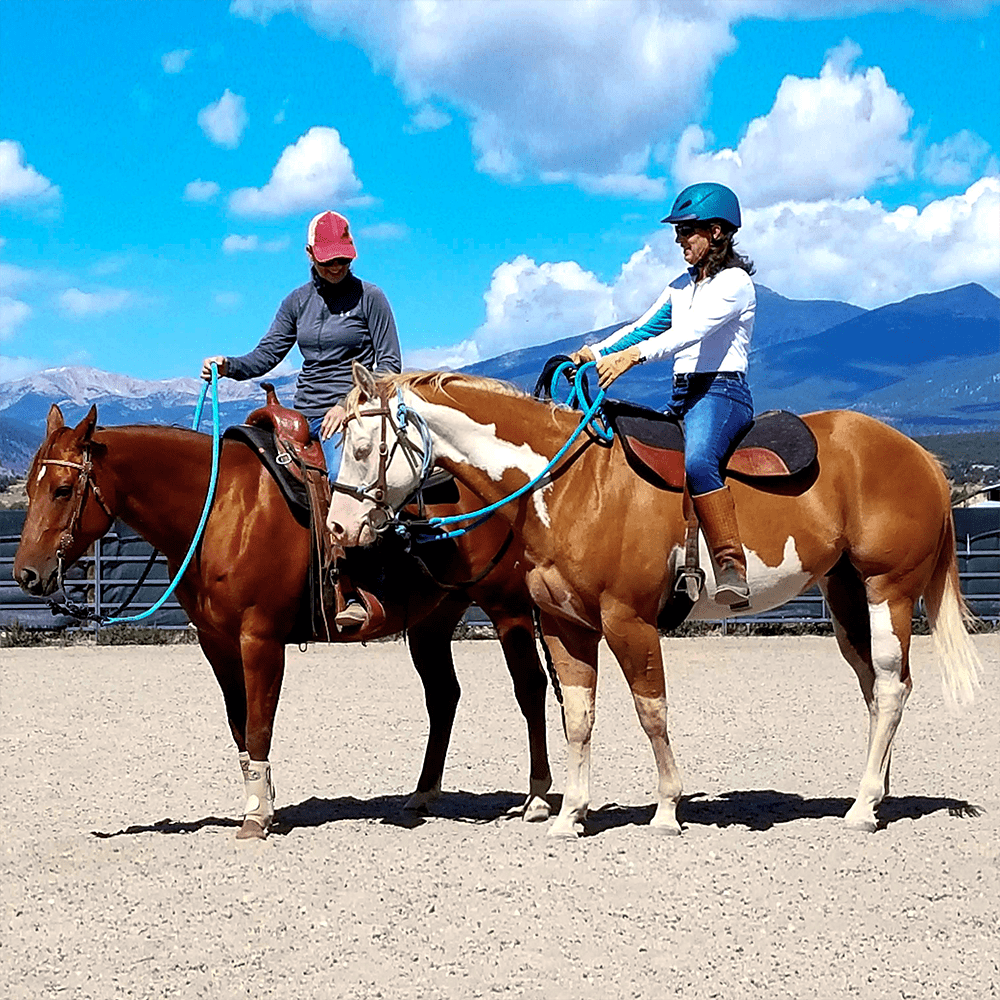Question Category: Issues from the Ground
Question: Dear Julie,
I recently purchased an 8 year old Shetland mare for my 5 year old daughter to ride, and she arrived at our barn a few days ago. The pony is difficult to catch in her stall and I would like some suggestions as to how to improve this situation. She came from a ranch where she ran in the pasture with the herd, and in order to catch her she was “herded” into a corral so she could be ridden by the 6 and 8 year old kids who lived there. She now lives in a stall in the mare barn at my boarding facility. When I enter her stall, she pins her ears and turns her hindquarters towards me. She likes to stop with her nose at a 45 degree angle into the corner, so she can turn her hindquarters towards me and block my approach to her head from either side. I have tried walking calmly towards her head, as you have described on your web site as a technique for hard to catch horses in the pasture; however in the small space of her stall she is very effective at positioning her body as she walks so that she can swing her butt around quickly towards you. I have even had her try to kick at me – I was a cautious distance away and she got nothing but air. Needless to say, my daughter is not allowed in the stall with the pony.
Once she is caught, she displays a slave-like obedience. She is very easy to lead. I have taken her into the round pen twice now. It seems that she hasn’t had much if any previous round pen work. I am able to get her to walk and trot, as well as reverse directions, but I am having trouble getting her to join up with me. I do work with a trainer who has emphasized the importance of round pen work and also suggested the pony might have had a bad experience with her previous owner’s kids. I will keep working in the round pen with her. In the meantime, do you have any suggestions for helping me to catch her safely and quickly in her stall? Since she has only been with us a few days, I would like to nip this behavior in the bud so it doesn’t get worse. I also own a massive Percheron gelding who has great ground manners. He trots up to his stall gate when he sees me approaching with his halter and practically puts his head in the halter for me. Needless to say, this little pony is a challenge for me and I am afraid I will get frustrated and angry if I don’t find a way to improve this situation soon.
Thanks for your help,
Pam
Tucson, AZ
Answer: Pam,
Sounds like you have done the right thing in getting your daughter a well-trained riding pony and this little glitch will be easily fixed. I wouldn’t jump to the conclusion that the pony has had bad experiences, she has just learned some clever pony tricks which is very typical. My son’s Shetland was a great ride except when he took you under the hitching rail to rub you off. I grew up on Shetlands that I learned to keep away from trees and low-lying branches for the same reason. They are clever little horses and because they are handled so much by children, they learn inventive techniques to get out of work.
It’s easy to solve this problem with this simple exercise for catching horses in stalls when they turn their butt to you. I would not use the same technique you mentioned above which is for horses that are hard to catch out in the field and run away from you. For this exercises, all you need is her halter with a lead rope attached (at least 8’ long). Halter and Lead set I suggest you use this technique yourself first until you get the desired results, then teach your daughter to do it under your direct supervision.
Hold the halter in one hand (your throwing arm) and the very end of the lead in your other hand. Enter the stall slowly and wait for the horse to turn and come to you. If instead she chooses to turn her butt to you, simply toss the halter at her, bumping her rear end. Make sure you stay well away from her kick range. Reel the halter in and keep tossing it at her rump until she gets annoyed and turns toward you to get her rump out of the way. Then immediately walk out of the stall as a reward and release of pressure for turning to you. Take a brief pause and then start over again entering the stall and throwing the halter if necessary. It may only take one or two throws before the pony gives up this antic (if your timing of the release is good), but you may have to reinforce this for a few days or longer to break a long-standing habit so always be prepared when you enter the stall and always give her a chance to turn and face you before you barge up to her (mares in particular can become very territorial in the stall– Horse Behavior: Territorial, Hormonal Mare
Whenever a horse turns his butt to you or even leans his hip toward you, it is a clear message that he is considering kicking you. Although many times this is a bluff, I would never take that for granted and always assume any horse will kick you under certain circumstances. Therefore it is imperative when you do this training exercise that you never come within kicking range of the horse. Remember that the kick zone is a half-circle around each hind leg—he can reach forward almost to his front leg, out to the side with full extension and behind him with full extension. When doing any type of ground work with horses, always be aware of where the kick zone is and make sure you stay safely out of it. This is one reason why we use a stick or whip for ground work but in this case, your halter and lead are acting as an extension of your arm so you can bump her on the rump without getting into the kick zone.
Your pony may have never been worked in the round pen because it is easy to cut corners when starting ponies under saddle. I would continue what you are doing and if you are using appropriate techniques, eventually she will join up with you. Some horses are more reticent than others and you must have more patience and persistence with them—pony mares are notorious for this. My video called Round Pen Reasoning DVD or Streaming Video goes through a step-by-step process for round pen techniques to establish authority over the horse, get the horse to accept you as leader and develop a line of communication with the horse. In the video I work with several different types of horses so you can see that some react differently than others, although the steps remain the same for all horses.
I think this pony will be fine once you establish some ground rules. Of course, 5 years old is about the youngest appropriate age for riding and at this age she needs qualified one-on-one supervision at all times. Also, particularly with small children, she should wear an equestrian helmet at any time she is around the pony—not just riding. When all safety precautions are taken, riding can be a wonderful family sport. Your daughter is lucky to have a horse-crazy mom with good horse sense!
Good luck,
Julie
Copyright ©Julie Goodnight 2000. All Rights Reserved. No part of this website may be reproduced without owner’s express consent.

